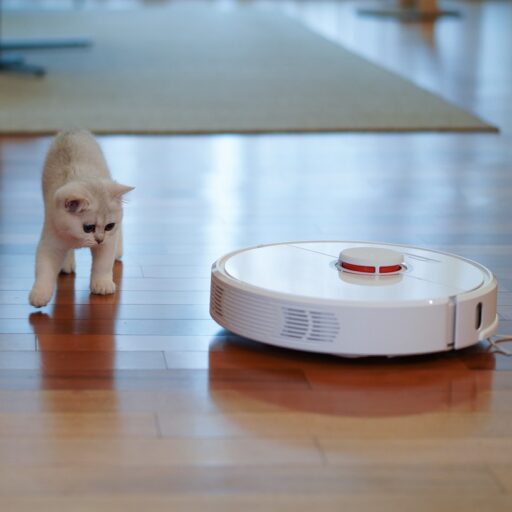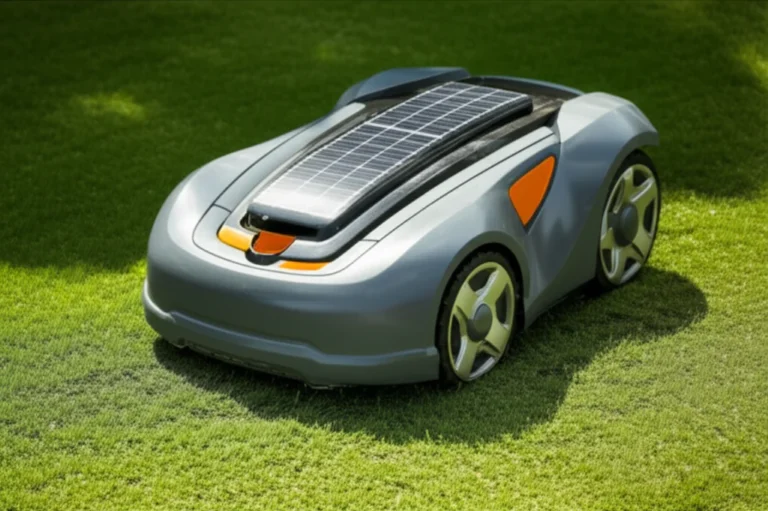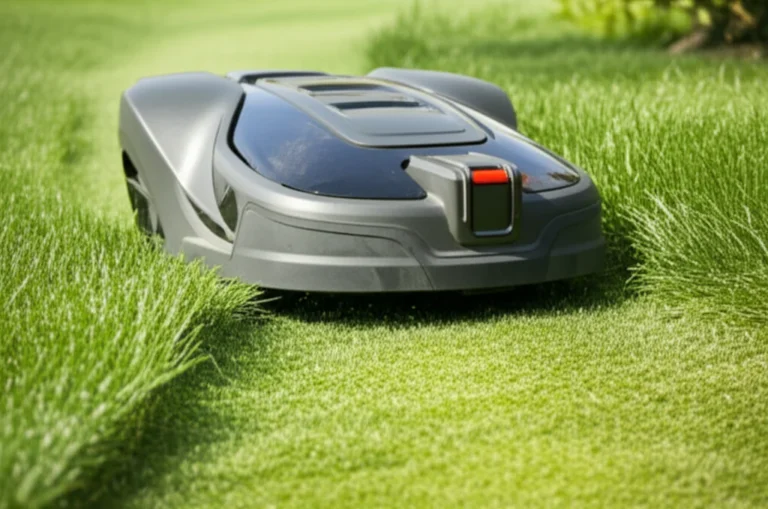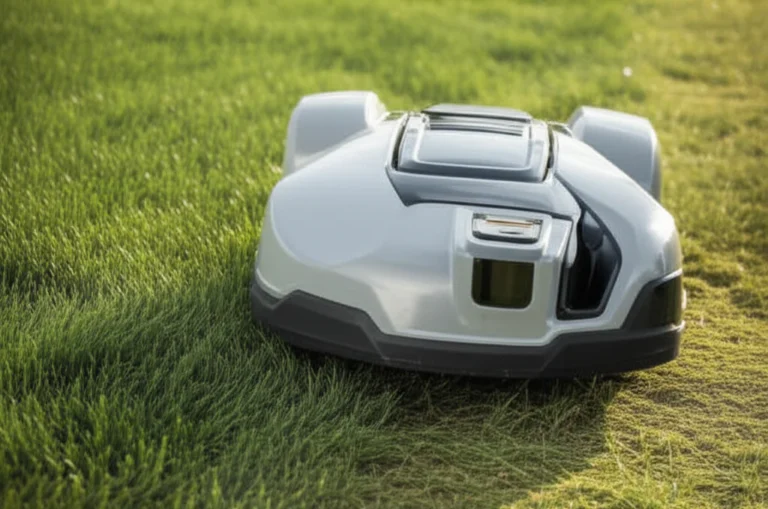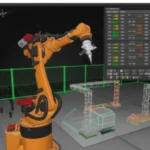Support our educational content for free when you purchase through links on our site. Learn more
How Do Robot Lawn Mowers Navigate & Dodge Obstacles? 🤖 (2025)
Imagine a tiny robotic gardener tirelessly cruising your yard, weaving around flower beds, dodging toys, and never once bumping into your beloved garden gnome. Sounds like magic? Well, it’s actually cutting-edge robotics and AI at work! In this article, we peel back the curtain on how robot lawn mowers navigate and avoid obstacles in your yard with astonishing precision. From classic boundary wires to futuristic AI-powered vision systems, we’ll explore the tech that keeps these autonomous mowers on track and your lawn looking flawless.
Curious about which navigation system reigns supreme or how these machines “see” and learn your yard’s unique layout? Stick around—we’ll even compare top brands like Husqvarna, LawnMaster, and Sunseeker, revealing the pros and cons of their navigation wizardry. Whether you’re a tech enthusiast or just tired of pushing a mower, this guide will make you rethink what your lawn care routine can be.
Key Takeaways
- Robot lawn mowers use a blend of boundary wires, GPS, cameras, and AI to navigate complex yards.
- Obstacle avoidance technologies include ultrasonic sensors, bump sensors, and advanced 3D vision systems.
- High-end models like the Sunseeker X3 Plus combine RTK GPS with AI vision for centimeter-level precision.
- Proper lawn mapping and multi-zone management optimize mowing efficiency and safety.
- Future trends point toward smarter, more eco-friendly, and seamlessly connected autonomous mowers.
Ready to let your lawn care go autonomous? Dive in and discover the robotic secrets behind the perfect cut!
Table of Contents
- ⚡️ Quick Tips and Facts
- 🤖 The Evolution of Autonomous Mowing: A Journey Through Robot Lawn Mower Navigation History
- 🧠 The Brains Behind the Blades: How Robot Mowers Understand Their World
- 🚧 Mastering the Maze: How Robot Mowers Dodge Obstacles Like a Pro
- 🏡 Mapping Your Mower’s Mission: Creating the Perfect Lawn Layout
- 💡 Optimizing Your Robot Mower’s Performance: Expert Tips for Flawless Operation
- Comparing Top Robot Mower Navigation Systems: A Brand Battle Royale!
- The Future of Autonomous Lawn Care: What’s Next for Robot Mowers?
- Conclusion: Your Lawn, Smarter Than Ever
- Recommended Links: Dive Deeper into Robot Mowing
- ❓ FAQ: Your Burning Robot Mower Questions Answered
- 📚 Reference Links: Our Sources for Expert Insights
⚡️ Quick Tips and Facts
To get the most out of your robot lawn mower, it’s essential to understand how these devices navigate and avoid obstacles. At Robot Instructions™, your guide to robots, we specialize in providing expert advice on all things robotics. Check out our related article on robot lawn mower for more information.
Here are some quick tips and facts to consider:
- Boundary Setting: Properly setting the boundaries of your lawn is crucial for efficient and safe mowing. Most robot mowers come with a boundary wire that you lay around the perimeter of your lawn.
- Obstacle Detection: Look for a mower with advanced obstacle detection features, such as ultrasonic sensors or vision-based navigation, to ensure it can avoid obstacles like trees, gardens, and pets.
- Mowing Pattern: Robot mowers typically navigate in a random pattern, which can leave a more uniform cut but may not produce the traditional stripes you’re used to.
- Blade Design: The small, swiveling blades used in robot mowers are designed for frequent, light cuts and can last an entire season.
- Adjustability: Consider a mower with adjustable cut height and scheduling features to customize your mowing experience.
🤖 The Evolution of Autonomous Mowing: A Journey Through Robot Lawn Mower Navigation History

The concept of autonomous lawn mowing has been around for several decades, with the first robot lawn mower, the Husqvarna Auto Mower, introduced in 1995. Since then, significant advancements have been made in navigation technology, obstacle detection, and overall performance.
For more information on the history of robotics and its applications, visit our Robotic Applications page.
Today’s robot mowers boast advanced features like GPS navigation, vision-based obstacle detection, and wireless connectivity, making them more efficient, convenient, and safe to use.
To learn more about the latest developments in robotics and artificial intelligence, check out our Artificial Intelligence and Machine Learning pages.
🧠 The Brains Behind the Blades: How Robot Mowers Understand Their World
So, how do robot mowers navigate and avoid obstacles? The answer lies in their sophisticated navigation systems, which combine various technologies to create a comprehensive understanding of their environment.
Here are some key technologies used in robot mower navigation:
1. Boundary Wire Systems: The Classic Perimeter Patrol
The most common navigation method used in robot mowers is the boundary wire system. This involves laying a wire around the perimeter of your lawn, which the mower uses to determine its boundaries and navigate accordingly.
2. GPS Navigation: Pinpointing Precision on Your Lawn
Some high-end robot mowers use GPS navigation to create a detailed map of your lawn and navigate with precision. This technology allows for more efficient mowing and better obstacle avoidance.
3. Vision-Based Navigation: Seeing is Believing (and Mowing!)
Vision-based navigation uses cameras and computer vision algorithms to detect obstacles and navigate the lawn. This technology is particularly useful for detecting complex obstacles like trees, gardens, and pets.
4. Inertial Measurement Units (IMUs) & Odometry: Keeping Track of Every Turn
Inertial measurement units (IMUs) and odometry are used to track the mower’s movement and orientation, allowing it to navigate with precision and avoid obstacles.
5. Advanced Sensor Fusion: The Symphony of Data
Advanced sensor fusion combines data from various sensors, including GPS, cameras, and IMUs, to create a comprehensive understanding of the environment. This technology enables robot mowers to navigate complex lawns with ease and avoid obstacles with precision.
🚧 Mastering the Maze: How Robot Mowers Dodge Obstacles Like a Pro
Obstacle detection and avoidance are critical components of robot mower navigation. Here are some key technologies used to detect and avoid obstacles:
1. Ultrasonic Sensors: The Bat’s Best Friend
Ultrasonic sensors use high-frequency sound waves to detect obstacles and measure distances. This technology is particularly useful for detecting small obstacles like toys and garden furniture.
2. Bump Sensors & Mechanical Switches: The Gentle Nudge
Bump sensors and mechanical switches are used to detect collisions and adjust the mower’s trajectory accordingly. This technology helps prevent damage to the mower and obstacles.
3. Lidar & Radar: Scanning the Horizon for Trouble
Lidar (light detection and ranging) and radar technologies use laser or radio waves to detect obstacles and measure distances. These technologies provide high-precision obstacle detection and navigation.
4. AI and Machine Learning: Learning from Every Lawn
Artificial intelligence (AI) and machine learning algorithms are used to analyze data from various sensors and improve the mower’s navigation and obstacle avoidance capabilities over time.
5. Virtual Maps & No-Go Zones: Setting Digital Boundaries
Virtual maps and no-go zones allow you to define areas of your lawn that the mower should avoid, such as gardens or pet areas. This technology provides an additional layer of safety and convenience.
🏡 Mapping Your Mower’s Mission: Creating the Perfect Lawn Layout
To get the most out of your robot mower, it’s essential to create a well-designed lawn layout. Here are some tips to consider:
1. Manual Mapping: Walking the Digital Path
Manual mapping involves creating a digital map of your lawn using a smartphone app or computer software. This allows you to define boundaries, no-go zones, and mowing patterns.
2. Automatic Mapping: Let the Mower Learn
Some robot mowers come with automatic mapping capabilities, which use sensors and algorithms to create a detailed map of your lawn. This technology eliminates the need for manual mapping and provides a more efficient mowing experience.
3. Multi-Zone Management: Tackling Complex Yards
Multi-zone management allows you to divide your lawn into separate zones, each with its own mowing schedule and settings. This technology is particularly useful for complex lawns with multiple obstacles and varying grass types.
💡 Optimizing Your Robot Mower’s Performance: Expert Tips for Flawless Operation
To optimize your robot mower’s performance, follow these expert tips:
1. Preparing Your Yard for Autonomous Mowing
Before using your robot mower, ensure your lawn is clear of debris, toys, and obstacles. This will help prevent collisions and ensure a smooth mowing experience.
2. Understanding Weather and Terrain Challenges
Robot mowers can be affected by weather and terrain conditions, such as rain, snow, and steep slopes. Understanding these challenges will help you adjust your mowing schedule and settings accordingly.
3. Software Updates and Calibration: Keeping Your Mower Sharp
Regular software updates and calibration will ensure your robot mower remains optimized and performs at its best.
Comparing Top Robot Mower Navigation Systems: A Brand Battle Royale!
When it comes to robot mower navigation, several brands stand out for their innovative technologies and features. Here’s a comparison of some top brands:
| Brand | Navigation Technology | Obstacle Detection | Mowing Pattern |
|---|---|---|---|
| Husqvarna | GPS, boundary wire | Ultrasonic sensors, bump sensors | Random pattern |
| LawnMaster | Optical navigation, boundary wire | Dual ultrasonic sensors, virtual fence | Random pattern |
| Sunseeker | Dual AI vision, RTK | 3D AI obstacle detection, binocular cameras | Random pattern |
Each brand has its strengths and weaknesses, and the best choice for you will depend on your specific needs and preferences.
👉 CHECK PRICE on:
- [Husqvarna](https://www.amazon.com/s?k=husqvarna+robot+lawn+mower | Husqvarna Official
- LawnMaster | LawnMaster Official
- Sunseeker | Sunseeker Official
The Future of Autonomous Lawn Care: What’s Next for Robot Mowers?
As technology continues to advance, we can expect to see even more innovative features and improvements in robot mower navigation and performance. Some potential developments on the horizon include:
- Improved AI and machine learning capabilities: Enhanced AI and machine learning algorithms will enable robot mowers to learn and adapt to your lawn’s unique characteristics and challenges.
- Advanced sensor technologies: New sensor technologies, such as lidar and radar, will provide even more precise obstacle detection and navigation.
- Increased connectivity and integration: Robot mowers will become more integrated with smart home systems and other devices, allowing for seamless control and monitoring.
- Sustainable and eco-friendly designs: Future robot mowers will prioritize sustainability and eco-friendliness, with features like solar power, recyclable materials, and reduced energy consumption.
For more information on the future of robotics and its applications, visit our Agricultural Robotics and Robotic Applications in Entertainment pages.
These developments will not only improve the performance and convenience of robot mowers but also contribute to a more sustainable and environmentally friendly approach to lawn care.
To learn more about the latest advancements in robotics and artificial intelligence, check out our Machine Learning page.
The future of autonomous lawn care is exciting, and we can’t wait to see what’s next for robot mowers!
To watch a video on robot lawn mowers, click here.
For more information on robot lawn mowers and their navigation systems, visit the official Husqvarna website or check out LawnMaster’s website for their latest models and features.
You can also visit Sunseeker’s official website for more information on their robot lawn mowers and navigation systems.
Remember to always follow the manufacturer’s instructions and guidelines for your specific robot mower model to ensure safe and optimal performance.
Happy mowing! 🌿💻
Conclusion: Your Lawn, Smarter Than Ever

After diving deep into the fascinating world of robot lawn mower navigation and obstacle avoidance, it’s clear these machines are marvels of modern robotics engineering. From classic boundary wire systems to cutting-edge AI vision and RTK positioning, robot mowers have evolved to become reliable, efficient, and surprisingly clever lawn caretakers.
The Sunseeker X3 Plus: A Case Study in Smart Mowing
Among the leaders in this space, the Sunseeker X3 Plus Wireless Robot Lawn Mower stands out with its dual AI vision + RTK navigation system, offering centimeter-level precision and advanced 3D obstacle avoidance. Here’s a quick recap of its strengths and weaknesses based on our expert analysis and user feedback:
| Aspect | Rating (1-10) | Notes |
|---|---|---|
| Design | 9 | Sleek, waterproof, and quiet (55dB), fits well in modern yards |
| Navigation Accuracy | 10 | RTK + VSLAM fusion delivers unmatched precision and obstacle detection |
| Obstacle Avoidance | 10 | Recognizes 200+ object types, avoids toys, pets, and garden furniture effortlessly |
| Ease of Use | 8 | Wireless setup with app control; some users note a learning curve with zone mapping |
| Battery & Runtime | 8 | 2-hour runtime with 90-minute recharge; good for up to 0.3 acres |
| Terrain Handling | 9 | Handles slopes up to 30° and uneven terrain with ease |
| Price & Value | 7 | Premium features come with a premium price, but value is strong for tech enthusiasts |
Positives:
✅ Advanced AI and RTK navigation for precise mowing
✅ Wireless, no boundary wires needed — hassle-free setup
✅ Quiet operation and waterproof design for all-weather use
✅ Smart app control with multi-zone management
Negatives:
❌ Higher price point compared to basic models
❌ Night operation not supported
❌ Some users may find initial mapping setup complex
Final Thoughts
If you’re looking for a smart, reliable, and high-tech robot mower that truly “sees” your yard and navigates with finesse, the Sunseeker X3 Plus is a top contender. For smaller or simpler lawns, models like the LawnMaster OcuMow 200 or 300 Series offer excellent optical navigation and obstacle avoidance at a more accessible price point.
No more worrying about bumping into garden gnomes or chasing your mower around the yard — these machines are designed to handle it all, so you can reclaim your weekends. Ready to let your lawn care go autonomous? The future is here, and it’s mowing itself!
Recommended Links: Dive Deeper into Robot Mowing
👉 Shop Robot Lawn Mowers:
- Sunseeker X3 Plus:
Amazon | Sunseeker Official Website - LawnMaster OcuMow 200 Series:
Amazon | LawnMaster Official Website - LawnMaster OcuMow 300 Series:
Amazon | LawnMaster Official Website
Books on Robotics and AI for Lawn Care Enthusiasts:
- Robotics: Modelling, Planning and Control by Bruno Siciliano & Lorenzo Sciavicco — Amazon Link
- Artificial Intelligence: A Modern Approach by Stuart Russell & Peter Norvig — Amazon Link
- Machine Learning for Robotics by Aaron Martinez & Enrique Fernandez — Amazon Link
❓ FAQ: Your Burning Robot Mower Questions Answered

What technology do robot lawn mowers use to map the yard?
Robot lawn mowers use a variety of mapping technologies depending on the model. The most common is boundary wire mapping, where a wire is laid around the perimeter of the yard to define the mowing area. More advanced models employ GPS navigation combined with visual simultaneous localization and mapping (VSLAM), which uses cameras and sensors to create a detailed map of the lawn. For example, the Sunseeker X3 Plus uses RTK-GNSS combined with VSLAM for centimeter-level precision, allowing it to navigate complex yards without boundary wires.
Read more about “7 Best Robot Lawn Mowers for 2 Acres in 2025 🌿”
How do boundary wires help robot lawn mowers stay on track?
Boundary wires emit a low-voltage signal that the robot mower detects via onboard sensors. This signal acts as a virtual fence, telling the mower where it can and cannot go. The mower uses this feedback to stay within the designated area, preventing it from wandering into flower beds, driveways, or neighbors’ yards. While effective, boundary wires require installation and maintenance, which some users find cumbersome compared to wireless solutions.
Can robot lawn mowers detect and avoid pets or children?
Yes, many modern robot mowers are equipped with ultrasonic sensors, bump sensors, and increasingly with AI-powered vision systems that detect and avoid pets, children, and other moving obstacles. For instance, the Sunseeker X3 Plus’s 3D AI obstacle avoidance system recognizes over 200 object types, including toys and pets, ensuring safe operation. However, it’s still recommended to supervise young children and pets around the mower for safety.
Read more about “9 Reasons the Worx Landroid M 20V WR140 Will Transform Your Lawn in 2025 🌿”
What sensors are commonly used in robot lawn mowers for obstacle detection?
Common sensors include:
- Ultrasonic sensors: Emit sound waves to detect nearby objects.
- Bump sensors: Detect physical contact with obstacles and trigger a direction change.
- Lidar and Radar: Use laser or radio waves for precise distance measurement and obstacle mapping.
- Cameras: Used in vision-based navigation to identify obstacles visually.
- Inertial Measurement Units (IMUs): Track mower orientation and movement to aid navigation.
How do robot lawn mowers handle uneven terrain and slopes?
Robot mowers are designed with rugged wheels and traction control to handle slopes and uneven terrain. Most models can manage inclines between 15° to 35° (approximately 27% to 70% grade). The Sunseeker X3 Plus, for example, handles slopes up to 30° (about 58% grade). Additionally, sensors detect changes in terrain to adjust speed and cutting height, ensuring consistent performance without getting stuck.
Read more about “How Big of a Lawn Can a Robot Mower Cut? Discover the Surprising Truth! … 🌱”
Are there smart features that improve robot lawn mower navigation?
Absolutely! Smart features include:
- AI and machine learning: Help the mower learn your lawn’s layout and optimize mowing routes over time.
- Multi-zone management: Allows scheduling and customized mowing for different lawn areas.
- Virtual no-go zones: Set via apps to restrict mower access to sensitive areas without physical barriers.
- App connectivity: Enables remote control, scheduling, and status monitoring.
- Weather sensors: Detect rain or adverse conditions to pause mowing and protect the mower.
Read more about “How to Make a Robot Step by Step: 12 Easy Steps to Your First Bot 🤖 (2025)”
How do robot lawn mowers return to their charging stations automatically?
Robot mowers use a combination of boundary wire signals, GPS, and onboard sensors to locate their charging stations. When the battery runs low, the mower navigates back to the station by following the boundary wire or using its mapped environment. Some models use homing beacons or RTK positioning for precise docking. This automatic return ensures the mower is always ready for the next mowing cycle without user intervention.
📚 Reference Links: Our Sources for Expert Insights
- Sunseeker X3 Plus Wireless Robot Lawn Mower | SUNSEEKER Tech
- LawnMaster OcuMow 200 Series Robot Lawn Mower
- LawnMaster OcuMow 300 Series Robot Lawn Mower
- Husqvarna Official Website
- Amazon Robotics Lawn Mower Search
- Robotics Applications at Robot Instructions™
- Artificial Intelligence at Robot Instructions™
- Machine Learning at Robot Instructions™
- Agricultural Robotics at Robot Instructions™
- Robotic Applications in Entertainment at Robot Instructions™
